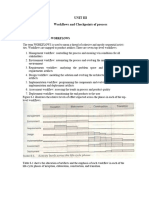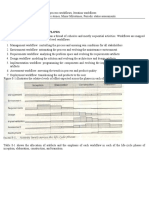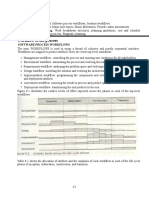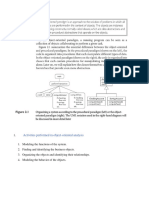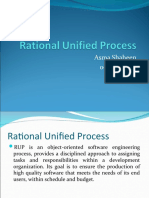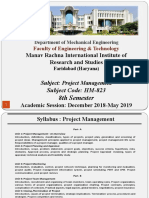V Model
V Model
Uploaded by
laddu1112Copyright:
Available Formats
V Model
V Model
Uploaded by
laddu1112Original Description:
Copyright
Available Formats
Share this document
Did you find this document useful?
Is this content inappropriate?
Copyright:
Available Formats
V Model
V Model
Uploaded by
laddu1112Copyright:
Available Formats
The V-Model (or VEE model) is a systems development model designed to simplify the understanding of the complexity associated
with developing systems.[2][3][4] In systems engineering it is used to define a uniform procedure for product or project development
Overview
The V-model is a graphical representation of the systems development lifecycle. It summarizes the main steps to be taken in conjunction with the corresponding deliverables within computerized system validation framework. The VEE is a process that represents the sequence of steps in a project life cycle development. It describes the activities and results that have to be produced during product development. The left side of the VEE represents the decomposition of requirements, and creation of system specifications. The right side of the V represents integration of parts and their verification.[3][4][5][6][7] V stands for "Verification and Validation" 77. It is very similar to the Classic Waterfall model as it is quite rigid and it contains a lot of iteration.
Objectives
The V-Model provides guidance for the planning and realization of projects. The following objectives are intended to be achieved by a project execution:
Minimization of Project Risks: The V-Model improves project transparency and project control by specifying standardized approaches and describing the corresponding results and responsible roles. It permits an early recognition of planning deviations and risks and improves process management, thus reducing the project risk. Improvement and Guarantee of Quality: As a standardized process model, the V-Model ensures that the results to be provided are complete and have the desired
quality. Defined interim results can be checked at an early stage. Uniform product contents will improve readability, understandability and verifiability.
Reduction of Total Cost over the Entire Project and System Life Cycle: The effort for the development, production, operation and maintenance of a system can be calculated, estimated and controlled in a transparent manner by applying a standardized process model. The results obtained are uniform and easily retraced. This reduces the acquirers dependency on the supplier and the effort for subsequent activities and projects. Improvement of Communication between all Stakeholders: The standardized and uniform description of all relevant elements and terms is the basis for the mutual understanding between all stakeholders. Thus, the frictional loss between user, acquirer, supplier and developer is reduced.
You might also like
- Merger Integration at The BoA - DraftDocument15 pagesMerger Integration at The BoA - Draftstareo3375% (4)
- First Principles Estimating PDFDocument7 pagesFirst Principles Estimating PDFMuaf Faizudeen67% (3)
- Oracle Unified Methodology (Oum) : Project Execution and Control PhaseDocument5 pagesOracle Unified Methodology (Oum) : Project Execution and Control PhaseKeshav ChittipoluNo ratings yet
- Responsibility Matrix - MSF CmmiDocument5 pagesResponsibility Matrix - MSF CmmiSameerIlyasPathan67% (3)
- Area Planner - Nadeem Manjar Resume 15.03.21Document3 pagesArea Planner - Nadeem Manjar Resume 15.03.21Manjar NadeemNo ratings yet
- ppmp20010 t1 2020 Assessment 1 Briefing Slides - 1193712248Document9 pagesppmp20010 t1 2020 Assessment 1 Briefing Slides - 1193712248Soumyodeepa KarNo ratings yet
- Vee ModelDocument2 pagesVee ModelCeleste Del Mundo CredoNo ratings yet
- Checkpoints of The Process: Unit - VDocument17 pagesCheckpoints of The Process: Unit - VvivekNo ratings yet
- SPM UNIT-3Document47 pagesSPM UNIT-3maram gayathriNo ratings yet
- Lec3 & 4 - System Development LifecycleDocument71 pagesLec3 & 4 - System Development LifecyclePriyanka SharmaNo ratings yet
- Waterfall ModelDocument8 pagesWaterfall Modelmrharshitha793No ratings yet
- Unit 3Document20 pagesUnit 3laxmi.pamulaparthyNo ratings yet
- Embedded Systems Design 10EC74Document17 pagesEmbedded Systems Design 10EC74Utkarsh Money earningNo ratings yet
- SPM Mid2Document14 pagesSPM Mid2RAKESH NALAMARINo ratings yet
- Handout 4 Intro Software Processes for KU 2020S SEDocument22 pagesHandout 4 Intro Software Processes for KU 2020S SENoorulain AnnyNo ratings yet
- Unit 3 DocsDocument16 pagesUnit 3 DocsRaju Jacob RajNo ratings yet
- SPPM Unit 3Document19 pagesSPPM Unit 3divya reddy100% (1)
- Software Assignment No1 Zohaib Ijaz 23811Document10 pagesSoftware Assignment No1 Zohaib Ijaz 23811tutorsandstudy3No ratings yet
- Lecture 3Document39 pagesLecture 3Mohammad NomanNo ratings yet
- Mis Unit 3Document67 pagesMis Unit 3Ashima WadhwaNo ratings yet
- SDLC V ModelDocument7 pagesSDLC V ModelUsman DogarNo ratings yet
- WaterfallDocument3 pagesWaterfallTeju MelapattuNo ratings yet
- Sno. Module As Per Session Planner Lecture No. PPT No.: Index Unit-V PPT SlidesDocument12 pagesSno. Module As Per Session Planner Lecture No. PPT No.: Index Unit-V PPT SlidesDmk ChaitanyaNo ratings yet
- BCS501 Model Question Paper SolutionsDocument25 pagesBCS501 Model Question Paper Solutionschococandy2023tNo ratings yet
- LaupDocument6 pagesLaupTK Lý Nguyễn Tuấn KiệtNo ratings yet
- Soniya Hariramani - Advance Software Engineering IADocument9 pagesSoniya Hariramani - Advance Software Engineering IAsoniya hariramaniNo ratings yet
- Chapter 2 ProcessesDocument58 pagesChapter 2 ProcessesAlma HodzicNo ratings yet
- V ModelDocument15 pagesV Modelmichael gordilloNo ratings yet
- Unit 2 NOtes SPMDocument10 pagesUnit 2 NOtes SPMAshish Singh RAJPUTNo ratings yet
- What Is SDLCDocument5 pagesWhat Is SDLCRishi GuptaNo ratings yet
- Unit 6Document15 pagesUnit 6adik4420No ratings yet
- 1.3 Process ModelDocument20 pages1.3 Process Modelpradeepkm6122004No ratings yet
- Accounting Information System: V-Shaped Model System DevelopmentDocument19 pagesAccounting Information System: V-Shaped Model System DevelopmentAmina AbdellaNo ratings yet
- OOSE Full NotesDocument94 pagesOOSE Full NotesNepse KingNo ratings yet
- Integrating SQA Into SDLCDocument47 pagesIntegrating SQA Into SDLCARDILLA FIROSYANo ratings yet
- Sppm-Unit III Precise NotesDocument13 pagesSppm-Unit III Precise NotesWriter in the darkNo ratings yet
- Software ProcessDocument18 pagesSoftware ProcessAnil NaikNo ratings yet
- IA 1 QaDocument5 pagesIA 1 QaVINAYAKA.KNo ratings yet
- Spiral ModelDocument3 pagesSpiral ModelIndra Arif RamadhanNo ratings yet
- Models of SDLC - PPT OriginalDocument51 pagesModels of SDLC - PPT Originals_coolbugNo ratings yet
- SDLC - V-ModelDocument5 pagesSDLC - V-Modelpalvi kapurNo ratings yet
- Unit 4 AnswersDocument1 pageUnit 4 AnswersrachitamandannaNo ratings yet
- Software Project Management Unit - 2 NotesDocument20 pagesSoftware Project Management Unit - 2 Notesshrey.bhaskar.it.2021No ratings yet
- Unit 2 SAD IctDocument20 pagesUnit 2 SAD Ictbishal000baniyaNo ratings yet
- Question Bank-2Document28 pagesQuestion Bank-2samacc0907No ratings yet
- Software EngineeringDocument70 pagesSoftware EngineeringAnam TahirNo ratings yet
- Software Process ModelsDocument10 pagesSoftware Process ModelsTahreem MasoodNo ratings yet
- Asma Shaheen 09-Ms-Se-07Document40 pagesAsma Shaheen 09-Ms-Se-07Sana AliNo ratings yet
- Introduction To Software Engineering: Week 3 (Lecture 5,6) Maha ButtDocument65 pagesIntroduction To Software Engineering: Week 3 (Lecture 5,6) Maha ButtAhmedNo ratings yet
- Project Phases and The Life CycleDocument13 pagesProject Phases and The Life CycleHįręń Gáńdhį100% (3)
- DR K R K - SE Unit 1Document99 pagesDR K R K - SE Unit 1Kanak MorNo ratings yet
- Introduction To Software EngineeringDocument32 pagesIntroduction To Software EngineeringMuhammad MoizNo ratings yet
- Software Engineering Unit2Document80 pagesSoftware Engineering Unit2hrithik04350No ratings yet
- AssingmentDocument4 pagesAssingmentIslam SaleemNo ratings yet
- Unit 2Document19 pagesUnit 2mastersin2022No ratings yet
- AssignmentDocument24 pagesAssignmentAina SiddiquiNo ratings yet
- 1.s/w Developm Ent Life Cycle:: Bqcqb1Document53 pages1.s/w Developm Ent Life Cycle:: Bqcqb1Raghav RohillaNo ratings yet
- TichHopHeThong BaiNhomDocument9 pagesTichHopHeThong BaiNhomkhong thichduaNo ratings yet
- V-Model: Kuliah Metode Dan Model Pengembangan Perangkat LunakDocument13 pagesV-Model: Kuliah Metode Dan Model Pengembangan Perangkat LunakFatih Cah JogjaNo ratings yet
- Contact Me To Get Fully Solved Smu Assignments/Project/Synopsis/Exam Guide PaperDocument10 pagesContact Me To Get Fully Solved Smu Assignments/Project/Synopsis/Exam Guide PaperMrinal KalitaNo ratings yet
- Dpit 023 V-ModelDocument5 pagesDpit 023 V-Modeltoroitich Titus markNo ratings yet
- System Development Life CycleDocument8 pagesSystem Development Life CycleAyan MandalNo ratings yet
- Aaron Course Work - 100752Document13 pagesAaron Course Work - 100752aaronmafabi73No ratings yet
- Process Models Part 1Document26 pagesProcess Models Part 1haseebbaloch43No ratings yet
- Introduction to Project Management: The Quick Reference HandbookFrom EverandIntroduction to Project Management: The Quick Reference HandbookNo ratings yet
- Lean Project ManagementDocument76 pagesLean Project ManagementAbel Quianga100% (1)
- Unit 1 - PMDocument34 pagesUnit 1 - PMshadyNo ratings yet
- Master Governance PlanDocument21 pagesMaster Governance PlanMichelle SaverNo ratings yet
- New Harvard Style CV!!!!Document2 pagesNew Harvard Style CV!!!!Farrah NabillaNo ratings yet
- Set A Long Questions: (10 2 10) Attempt Any TwoDocument2 pagesSet A Long Questions: (10 2 10) Attempt Any Twosetup vpnNo ratings yet
- Inspector General Sunpass Final ReportDocument61 pagesInspector General Sunpass Final Report10News WTSPNo ratings yet
- CENG 6101 Project Management: Wubishet Jekale Mengesha (Dr. Eng.) July, 2014Document73 pagesCENG 6101 Project Management: Wubishet Jekale Mengesha (Dr. Eng.) July, 2014Abera Mamo JaletaNo ratings yet
- Project Universal Patient Record SystemDocument25 pagesProject Universal Patient Record Systemapi-59751528No ratings yet
- Primavera p6Document3 pagesPrimavera p6Siti Norsyazwani OthmanNo ratings yet
- Course WorkbookDocument230 pagesCourse WorkbookRaghu Venkata100% (1)
- Vice President Facilities Real Estate in San Diego CA Resume Douglas StockerDocument2 pagesVice President Facilities Real Estate in San Diego CA Resume Douglas StockerDouglasStockerNo ratings yet
- 07dka21f1059 - Siti Aisyah SaibiDocument6 pages07dka21f1059 - Siti Aisyah SaibiAzhar AndikanNo ratings yet
- Introduction To Project ManagementDocument61 pagesIntroduction To Project Managementvinunair79No ratings yet
- CharterDocument80 pagesCharterVaishnavi SomaniNo ratings yet
- CV - SumbittedDocument4 pagesCV - SumbittedMarvin VallegaNo ratings yet
- Aditi Srivastava - Gcad17205construction Management IxDocument4 pagesAditi Srivastava - Gcad17205construction Management IxAditi SrivastavaNo ratings yet
- The PMO Survival GuideDocument4 pagesThe PMO Survival GuideyveseoneNo ratings yet
- Book9 ProjectRiskManagement TOCDocument22 pagesBook9 ProjectRiskManagement TOCtatyanadelay544No ratings yet
- L1-Juan Kasal App Web Based Application For Event PlaDocument14 pagesL1-Juan Kasal App Web Based Application For Event Plakingsman51600No ratings yet
- PMI Agile Certified Practitioner (PMI-ACP) HandbookDocument55 pagesPMI Agile Certified Practitioner (PMI-ACP) HandbookmicheledevasconcelosNo ratings yet
- Profile Synopsis: Core CompetenciesDocument2 pagesProfile Synopsis: Core Competenciesshubham agarwalNo ratings yet
- Katz Integration 2007Document126 pagesKatz Integration 2007Raniiya epicNo ratings yet
- JBGP 0000 Civ Sow BPC 0000 00001 00 R0 PDFDocument41 pagesJBGP 0000 Civ Sow BPC 0000 00001 00 R0 PDFshafiq_05No ratings yet
- Planning and Costing in MultimediaDocument27 pagesPlanning and Costing in Multimediafaiza akram100% (2)
- A-Hr-Frm-0001 - JD Template New - SDM r1Document2 pagesA-Hr-Frm-0001 - JD Template New - SDM r1Sarveshrau SarveshNo ratings yet














